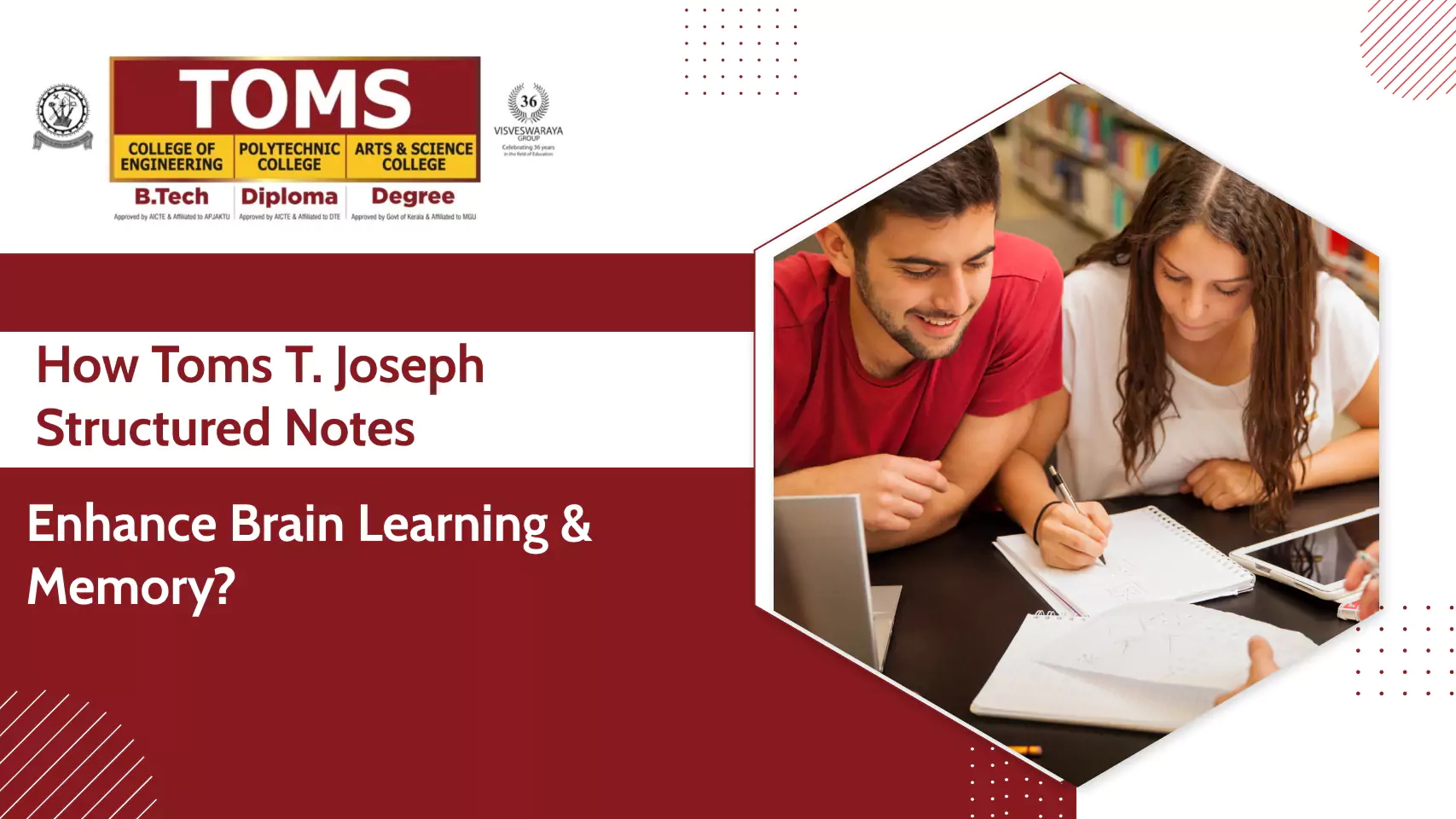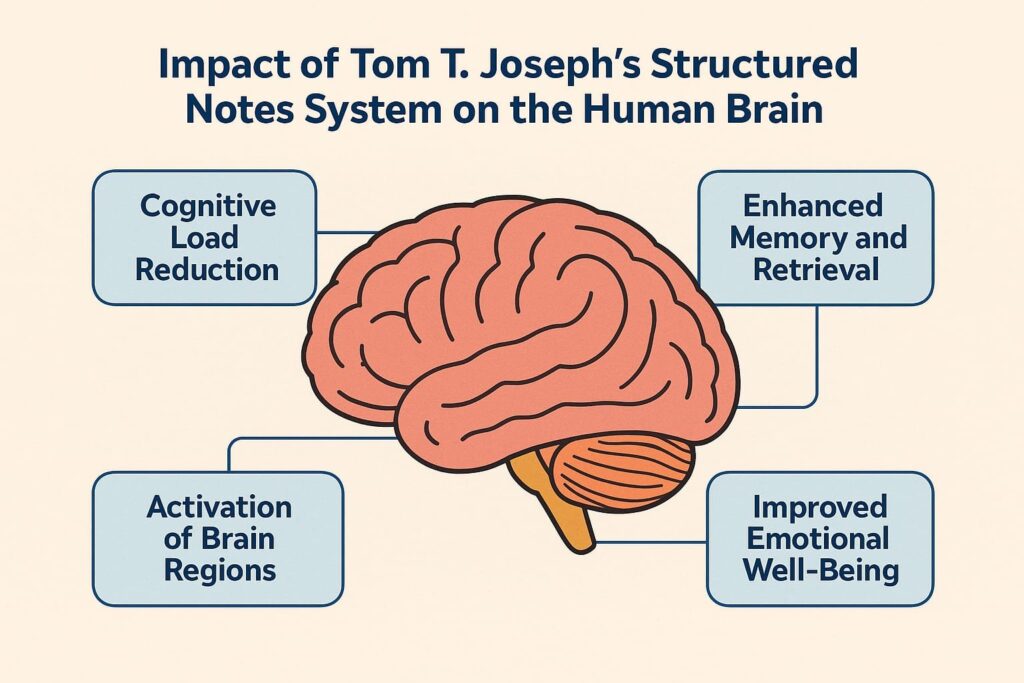
Today, AI has made it clear that education is not only about getting the facts but mastering them for life. This is where Tom T. Joseph's Structured Notes System revolutionizes the concept of learning. The method is not traditional note-taking, but in fact, brain learning items are digitized, modular, and logically ordered. This is how the method goes to the next level.
The latest ones to implement these principles are institutes like TOMS, including the private engineering colleges in Kerala, known for their excellence, that have such practices, resulting in student transformation. Let's explore the features of this system that make it different and understand its significance.
At first, most people think of the Structured Notes as only the most organized type of study cards. But the truth is they are much more than that. This method, developed by Tom T. Joseph in the late 1980s, restructures the academic content into chapters, subtopics, and objectives similar to cognitive memory sciences.
Compared to AI Automated Generated Notes or standard Smart Notes, the unique features of Structured Notes are designed to enhance:
Neuroscience is the science behind the Structured Notes approach, but it is not about traditional pedagogy, as it is the opposite of it. This way, it makes the learning process both scientific and easy to learn for the students.
The structured notes certainly don’t only achieve better organization, but they are also remarkable since they are so well in tune with the way the human brain learns, remembers, and thrives. For ages, doctors and the latest studies have presented evidence on the strong efficacy of structured notes. So, we can now examine the cognitive, emotional, and neurological aspects.

1. Reduces Cognitive Overload
Structured notes are a technique that allows breaking complicated subjects into smaller, more manageable sections. Doing this keeps your short-term memory from getting confused and lets you think about understanding the material rather than memorizing it.
2. Enhances Memory Encoding and Retrieval
Shared through Semantic Encoding, the Memory Pathways that Structured Notes make are Meaningful. Therefore, it is much easier to remember, recall, and use the facts, theories, and techniques learned during an exam or when solving real problems.
3. Activates Multiple Brain Regions
The process of learning by making structured notes is not at all passive. It brings the:
The state of being active in many different regions of the brain is how the brain comprehends and enhances learning in depth.
4. Strengthens Neuroplasticity and Long-Term Potentiation (LTP)
Repetition, along with a predetermined sequence of actions, constitutes a way of protecting visual traces. Over time, this alignment helps the knowledge stick, which in turn, supports long-lasting mastery beyond the classroom tests.
5. Boosts Metacognition and Executive Functions
Structured Notes motivate learners to take responsibility for learning, set goals, and evaluate their progress. Such a power helps develop key skills like flexible thinking, working memory, and self-control.
6. Improves Emotional Well-Being
Well-organized and prepared notes lessen students' academic stress. They are more self-assured, thus have a healthier and more positive learning experience if the learners are aware of the things to study and the reasons behind them.
7. Fosters Deep Learning and Conceptual Clarity
Less than memorizing by heart, students set out to learn by Structured Notes. The fitting of connecting concepts or the why of the fitting, thus transforming mere information into true, lasting knowledge.
The Structured Notes System is not just a theoretical concept; it has been practically adopted by some of the leading institutions in India, proving its effectiveness in the areas of student success, innovation, and placement.
A recent report of the structured note checked colleges based on five pillars like academic excellence, concept clarity, result orientation, mentorship, feedback, and the notes ecosystem. The Top 10 Emerging, Result-Oriented Engineering Colleges in India (2025) employing Structured Notes are:
|
Rank |
College Name |
Location |
Key Strength |
|
1️⃣ |
TOMS College of Engineering |
Kerala |
Full Structured Notes adoption, academic dashboards, and rural empowerment |
|
2️⃣ |
Shiv Nadar University |
Uttar Pradesh |
Personalized learning paths, strong outcome focus |
|
3️⃣ |
CV Raman Global University |
Odisha |
Modular notes, industry-aligned curriculum |
|
4️⃣ |
MIT World Peace University |
Maharashtra |
Value education + skill-based evaluation through Structured Notes |
|
5️⃣ |
Reva University |
Karnataka |
Concept mapping, internship-linked curriculum |
|
6️⃣ |
KPR Institute of Engineering and Technology |
Tamil Nadu |
Smart classrooms, placement-oriented teaching |
|
7️⃣ |
Graphic Era University |
Uttarakhand |
Affordable quality programs, peer-evaluation tools |
|
8️⃣ |
NIIT University |
Rajasthan |
Research-driven, project-based mentoring |
|
9️⃣ |
SR University (Warangal) |
Telangana |
AI/ML modules linked to Structured Notes |
|
🔟 |
Alliance University (SoE) |
Karnataka |
Blended pedagogy, real-time feedback integration |
Out of these, TOMS College of Engineering in Kerala is the one that has made a significant move. TOMS is the first to implement Structured Notes. The academic dashboards and Inclusive Education Programs are the two most popular among the best private engineering colleges in Kerala.
It is not all about the rankings, but rather if the college offers facilities that will help you learn smarter, not harder. The Top 10 Evolving Result-Oriented Engineering Colleges (2025) that utilize the Structured Notes System are distinctive. Their merging of science with modern academic practices, with theoretical and practical classes, is done in a way that is both serious and effective.
Here’s why these colleges are different:
|
Feature |
What Makes Them Stand Out |
|
Smart Notes |
All these colleges use Tom T. Joseph’s Structured Notes System, turning complex subjects into modular, layered notes that boost memory retention and deepen understanding. |
|
Feedback-integrated Assessments |
Regular mentorship and feedback loops ensure students always know where they stand and how to improve, reducing anxiety and improving performance. |
|
Skill-to-Project Pipelines |
Instead of focusing only on theory, these colleges connect classroom learning to hands-on projects and internships, preparing students directly for industry challenges. |
|
Learning Revision Templates |
Ready-to-use revision sheets and templates help students review smarter, leading to better exam performance and long-term mastery. |
When combined, these features form a robust ecosystem that helps students learn smartly, increase their memory, and acquire practical skills better than AI Generated Smart Notes.
The Structured Notes System is not merely a tool for academic purposes; it is a lifelong learning method derived from neuroscience research. It alters the way students learn, think, and succeed with reduced cognitive overload, the increase of memory encoding, and the strengthening of emotional resilience.
Structured Notes, on the other hand, demonstrate depth, clarity, and mastery - something that is always in style. Institutions that recognize this method, particularly focused on innovation, are training students for the real world, not just for tests.
As evidenced by the number of their peers, hundreds of adolescents have come to realize that learning fully is not only through memorizing but doing so more intelligently. We can learn this from the Structured Notes System.
How does the Structured Notes System improve memory and focus?
Breaking complex topics into logical, shorter modules is an effective way to reduce the cognitive load and boost long-term retention of knowledge by the process of semantic encoding.
What is the neuroscience behind the Structured Notes System?
It is based on methods such as chunking, long-term potentiation, and emotional regulation, which work for memorization and learning speed.
Can Structured Notes reduce academic stress and anxiety?
Certainly. It teaches the learners to be clear and certain first, and then it decreases uncertainty-helping the students be more confident and less anxious.
Are any colleges in India currently using this Structured Notes System?
Definitely. Notable colleges like TOMS College of Engineering, Shiv Nadar University, and MIT-WPU have also adopted it, and it is used in their learning ecosystem.
How is this system different from regular note-taking or coaching material?
Compared to plain summaries or Generated Notes, Structured Notes are constructed by the cognitive science principles, making the process of understanding and mastering the notes a lot deeper and more effective.



